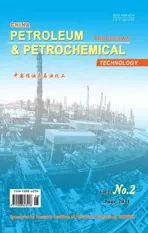High-efficiency Extraction of Bitumen from Oil Sands Using Mixture of Ionic Liquid [Emim][BF4] and Dichloromethane
2021-06-29SunYinluSunYizhuoJiaYushanYuanWeiSongXiming
Sun Yinlu; Sun Yizhuo; Jia Yushan; Yuan Wei; Song Ximing
(College of Chemistry, Liaoning University, Shenyang 110036)
Abstract: An ionic liquid (IL), 1-ethyl-3-methyl imidazolium tetrafluoroborate ([Emim][BF4]), was used to enhance bitumen recovery from oil sands by dichloromethane solvent extraction. A multiphase system could be formed by simply mixing the components at ambient temperature, consisting of sands and clays, mixtures of ionic liquid and dichloromethane,and concentrated bitumen layer. The results demonstrated that [Emim][BF4] increased the bitumen recovery up to 92%.Much less clay fines were found in the recovered bitumen than those formed by using dichloromethane solvent extraction alone, and the dichloromethane residue was not detected in the spent sands. We proposed that [Emim][BF4] had an ability to reduce the adhesion of bitumen to sand, resulting in an improved separation efficiency. Furthermore, [Emim][BF4] could facilitate the transfer of the extracted bitumen to the surface interface, and then the bitumen was auto-partitioned to a separate immiscible phase for ease of harvesting. This technology circumvented the issue of high consumption of distillation energy due to separation of bitumen phase and low boiling point of dichloromethane. [Emim][BF4] and dichloromethane could be readily recycled through the system and used repeatedly. After ten cycles, the bitumen recovery remained above 88%. Initial scale-up work suggested that this approach would form the basis for a viable large-scale process.
Key words: oil sands; bitumen extraction; dichloromethane; ionic liquid
1 Introduction
With the depletion of traditional oil resources and the deepening of energy crisis, it is urgent to develop new energy sources. Oil sand, a mixture of bitumen, water,sand and clay, has attracted worldwide attention as a potential crude oil equivalent. The bitumen, which is similar to heavy oil in nature, can be treated as high quality crude oil by hydrogenation and other processes.Many advanced technologies have been proposed to separate bitumen from oil sands[1].
One of the most popular approaches is the hot water extraction process, which has been successfully applied in the oil sands industry[2-3]. In this process, hot water and processing aids (NaOH) are added to the oil sands to form surfactants with carboxylic acid components in bitumen,so as to liberate bitumen from the minerals. However, this process requires numerous water consumption and energy use, and the fine minerals suspended in tailing water badly affect the subsequent processing.
Solvent extraction has been attracting an increasing attention because of its high extraction efficiency and mild technological conditions[4-7]. The aromatic solvents(benzene and toluene) are widely used due to their similar solubility with bitumen. However, the extensive application of this method may be limited by the facts that(i) these flammable and toxic solvents and their residue in the spent sands cause contamination, (ⅱ) the subsequent distillation of organic solvents requires numerous energy consumption due to their large amounts and high boiling points, and (ⅲ) clay fines in the recovered bitumen are difficult to remove.
In recent years, ionic liquids (ILs) have been proposed for enhancing solvent extraction of bitumen from oil sands[8-11]. ILs can decrease the adhesive force between bitumen and silica, facilitating the desorption and dissolution of bitumen[12-13]. Bitumen can be separated from minerals leaving the relatively clean sands, and the clay fines cannot be found in the recovered bitumen.However, the issues associated with selection of environmentally friendly solvents and high distillation energy consumption have been not yet addressed[14-16].
In this paper, we established a novel method,dichloromethane-[Emim][BF4] extraction, to efficiently separate bitumen from oil sands. The schematic diagram of oil sands separation is represented in Figure 1. Dichloromethane is characterized by low toxicity and weak molecular polarity, which is optimal for the extraction of bitumen. The extracted bitumen can be concentrated to form a separate phase due to the incorporation of [Emim][BF4]. The issues about high energy consumption can be effectively addressed as only a slight amount of solvent needs to be removed in subsequent distillation. High difference in boiling point between dichloromethane and [Emim][BF4] means both of them can also be easily recycled and reused, which can further decrease energy consumption. Bitumen separated by the new method has good quality without distinct mineral fines.
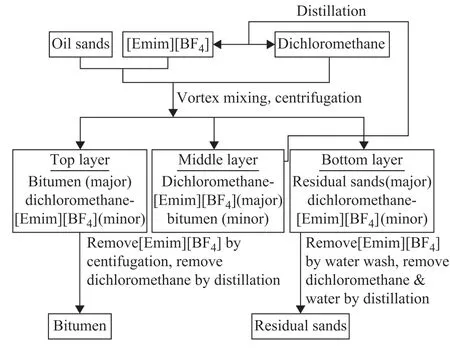
Figure 1 Schematic for dichloromethane extraction of bitumen assisted by [Emim][BF4]
2 Experimental
2.1 Reagents
The medium grade tar sand containing about 10% (by wet weight) bitumen was obtained from Inner Mongolia,China and used in this study.
Dichloromethane used for the solvent extraction, dilution and cleaning was purchased from the Aladdin Company. 1-Ethyl-3-methylimidazolium tetrafluoroborate ([Emim][BF4]) was selected in line with its relatively low viscosity, insolubility with the bitumen, and miscibility with dichloromethane molecules. 1-Butyl-2,3-dimethylimidazolium tetrafluoroborate ([Bmmim][BF4]) was used for comparison. Two kinds of ionic liquids were purchased from the Linzhou Science and Technology Co., Ltd.
2.2 Solvent extraction
Solvent extraction using dichloromethane alone was conducted by mixing dichloromethane and oil sands(4.0 ± 0.1 g) in a 50-mL test tube, followed by vortex mixing at a stirring speed of 1 200 r/min in 2 min at room temperature and centrifugation at 5 000 r/min for 3 min.The supernatant was decanted into a centrifugal tube, and fresh dichloromethane solvent was added to remove the remaining bitumen in the spent sands. The procedure was repeated until the dichloromethane was colorless.
The influence of IL addition on the dichloromethane solvent extraction was also investigated. In all cases,samples of oil sands (4.0 ± 0.1 g), ionic liquids (4.0 ±0.1 mL), and dichloromethane (10 mL) were weighed and added in sequence into a 50-mL test tube, followed by vortex mixing at a stirring speed of 1 200 r/min in 2 min at room temperature. After centrifugation at a rate of 5 000 r/min for 3 min, a multiphase system could be formed. Each phase was easily removed from the others using a pipette. All the extraction experiments were carried out in duplicate.
2.3 Characterization of bitumen
The bitumen product was weighed to determine the gravimetric yield. The original oil sand, the bitumen obtained by extraction, and the spent minerals were characterized using a Fourier transform infrared spectrometer (FTIR, Thermo Scientific Nicolet IMPACT-400). A wave number resolution of 4 cm-1and signal averaged 200 scans were used. Spectra of the original oil sands and spent minerals were obtained by KBr pressed disk method. Spectra of bitumen were obtained by casting dichloromethane solution onto KBr window followed by evaporating dichloromethane to form a thin film for analysis. The mobility and interaction of molecules in the system were monitored by measurement of the relaxation time of low-field nuclear magnetic resonance (LF-NMR, MicroMR23-025V) at room temperature.
3 Results and Discussion
3.1 Solvent extraction with dichloromethane
For comparative purpose, dichloromethane alone was used as extraction solvent for the oil sands. The dichloromethane solvent was removed from the extracted bitumen by distillation at 50 ℃ and collected in a recycle tank. The bitumen product was weighed to determine its recovery rate. The extraction experiments were repeated five times, and the recovery rate was 99.6%, 98.3%,102.0%, 103.4%, and 100.8%, respectively. Some clay fines were observed in the oven-dried bitumen, resulting in the values of bitumen recovery being even higher than 100%. The similar finding was also reported in recovered bitumen by toluene extraction[8]. We proposed that clay fines were more likely to be incorporated with the bitumen phase if the solvent has a larger density.These clay fines contained in the recovered bitumen were difficult to remove, which demonstrated the need for IL addition so as to obtain a clean bitumen separation effect.
3.2 Solvent extraction with dichloromethane assisted by ILs
Figure 2 indicates that there is a great difference between[Bmmim][BF4] and [Emim][BF4] in terms of the bitumen removal rate. During the extraction process enhanced by [Bmmim][BF4], a multiphase system was formed,consisting of sands and clays, a [Bmmim][BF4] layer with a small amount of dissolved bitumen particles, and a dichloromethane layer containing the bitumen. The similar phenomena could be observed in Painter’s[8,12]and Li’s[16-17]findings. However, during the oil sands extraction process enhanced by [Emim][BF4], the middle layer contained [Emim][BF4]-dichloromethane mixture with a small amount of dissolved bitumen particles, and the top was an auto-partitioned bitumen layer.
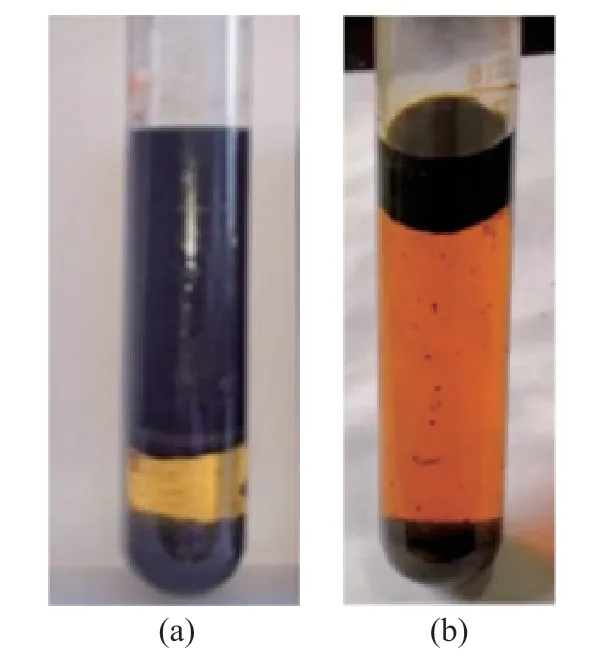
Figure 2 Multiphase systems formed by mixing oil sand with (a) [Bmmim][BF4] and (b) [Emim][BF4]
As different ionic liquid comes into contact with dichloromethane, the mobility of both [Bmmim][BF4]-CH2Cl2mixture and [Emim][BF4]-CH2Cl2mixture changes. These changes are detectable through changes in the LF-NMR relaxation characteristics of both mixtures.Figure 3 shows the spectra of the extracted bitumen, the[Bmmim][BF4]-CH2Cl2mixture, and the [Emim][BF4]-CH2Cl2mixture. Obviously, the spectra of two mixtures are distinctly different from the spectra of extracted bitumen. The peaks of extracted bitumen and [Bmmim][BF4]-CH2Cl2mixture partially overlapped between 200 ms and 1 073 ms. However, the [Emim][BF4]-CH2Cl2mixture peak shifted to longer relaxation time(811—4 978 ms) when [Emim][BF4] was introduced,leading to the fact that the bitumen peak was separated largely. These results can be attributed to the difference of solubility. Both ILs are hydrophilic, immiscible with bitumen but miscible with dichloromethane. However,[Emim][BF4] has a relatively higher polarity than[Bmmim][BF4] due to its shorter hydrophobic side group(ethyl group)[18], resulting in better miscibility of [Emim][BF4] with dichloromethane. Therefore, the extracted bitumen could hardly be dissolved in dichloromethane but was partitioned into a separate phase.
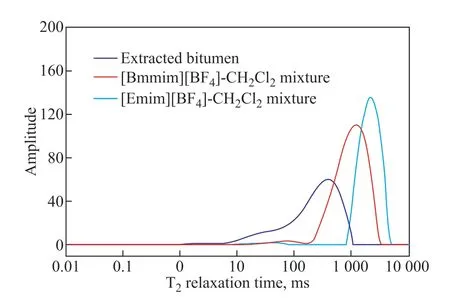
Figure 3 Typical LF-NMR spectra for extracted bitumen, [Bmmim][BF4]-CH2Cl2 mixture, and[Emim][BF4]-CH2Cl2 mixture
Figure 4 outlines a typical extraction process of bitumen from oil sands assisted by [Emim][BF4]. In order to show clearly, the quantity of all materials was increased by 10 times in proportion. The removed bitumen was suspended in [Emim][BF4]-CH2Cl2mixture at the start of the extraction process (Figure 4a). Bitumen was transferred to the surface and auto-partitioned to form a separate and stable phase (Figure 4b-c).Although [Emim][BF4] was hydrophilic, the presence of hydrophobic side groups (in our case ethyl and methyl groups) could be attached to the nitrogen(s) of the imidazolium ring to create hydrophobic regions. It was proposed that these side groups could be associated to create hydrophobic “tunnels” through which the immiscible bitumen could diffuse. The driving force was thermodynamic preference for ionic bonding between the cations and anions as opposed to hydrophobic interaction between the bitumen and the ethyl side chains. Furthermore, the density difference between[Emim][BF4]-CH2Cl2mixture and the extracted bitumen could improve the rapid transfer of the bitumen to the surface interface where the bitumen was subject to autopartition into a self-associating and separate phase.The similar findings were reported in the separation of biomass using ionic liquid-methanol co-solvents[19-21].However, such concentrated bitumen was not observed during the extraction process enhanced by [Bmmim][BF4]. [Bmmim][BF4] had a smaller polarity because of butyl group, which reduced its miscibility with dichloromethane. Therefore, the extracted bitumen was more readily dissolved in dichloromethane.
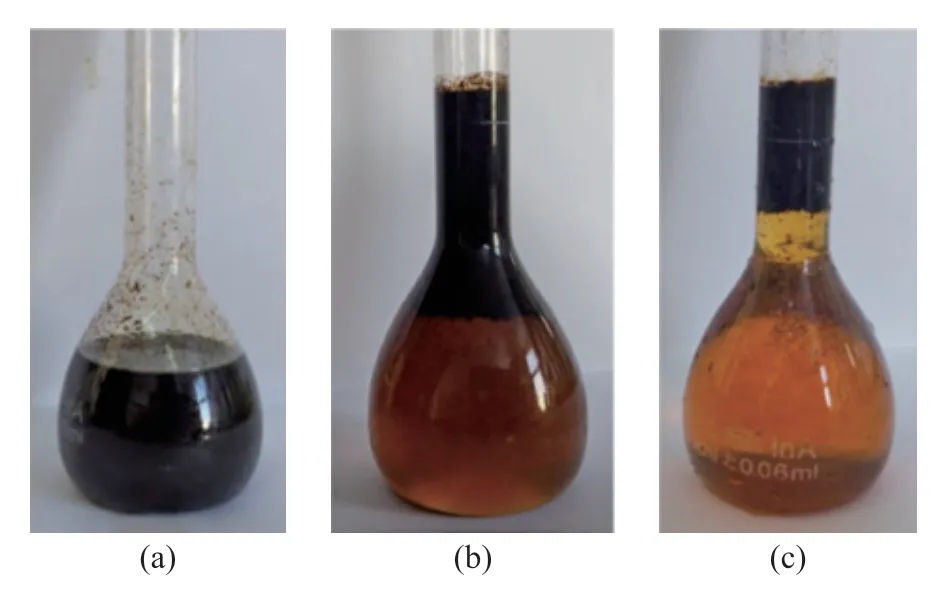
Figure 4 A typical extraction process of bitumen from oil sands assisted by [Emim][BF4](a) Extracted bitumen was suspended in [Emim][BF4]-CH2Cl2 mixture. (b) Bitumen transferred to the surface.(c) Bitumen auto-partitioned to a separate phase at the end of the extraction period
In the simple experiment described herein, each layer was simply removed from the phase-separated mixture using a pipette. [Emim][BF4] entrained in bitumen can be removed by repetitious centrifugation and collected in a recycle reagent bottle. A small amount of dichloromethane residue was removed by drying on the heating plate in a fume hood for 10 min at 50 ℃. Due to high difference in boiling point, dichloromethane and[Emim][BF4] mixture were easily separated and recycled by distillation. The residual sands and clays were treated by water washing for 2 — 3 times, followed by drying in a vacuum oven for 2 h at 105 ℃. The original oil sand, the bitumen obtained by extraction, and the spent sands and clays were identified by infrared spectrometry(Figure 5). The peaks in the 1 100 — 800 cm-1region were typical bands of minerals and clay fines; however,they were not observed in the spectrum of the bitumen.This indicated that by using [Emim][BF4] the bitumen could be separated from oil sands without carrying detectable clay fines. The peak near 2 930 cm-1was due to CH aliphatic stretching mode of bitumen. The extremely weak absorption near 2 930 cm-1observed in the spectrum of the spent sands and clays was at noise level, indicating that residual bitumen was negligible. Additionally, there was no issue of secondary pollution when the spent sand was released into the environment. Firstly, a negligible amount of dichloromethane was left in the spent sand because most dichloromethane was miscible with [Emim][BF4]. Secondly, the entrained IL had been washed away by water, which was evidenced by the absence of peaks between 1 300 cm-1and 1 600 cm-1due to [Emim][BF4](Figure 6) in the “fingerprint region” of spent sand.Although a strong absorption band (near 1 100 cm-1) in the spent sand partially overlapped with that of [Emim][BF4], it was not the evidence of [Emim][BF4] residue but the characteristic peaks of silicates. Similarly, there was no detectable [Emim][BF4] in the spectrum of the bitumen. The above results suggested high bitumen recovery rate could be obtained through clean separation.
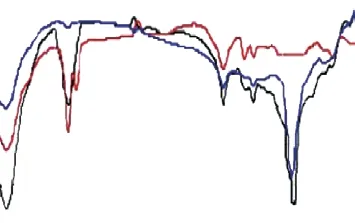
Figure 5 Infrared spectra of the original oil sand, the extracted bitumen, and the spent sand and clay
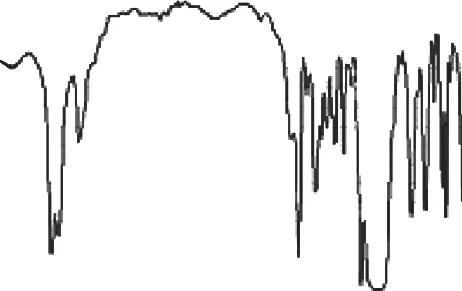
Figure 6 Infrared spectrum of pure [Emim][BF4]
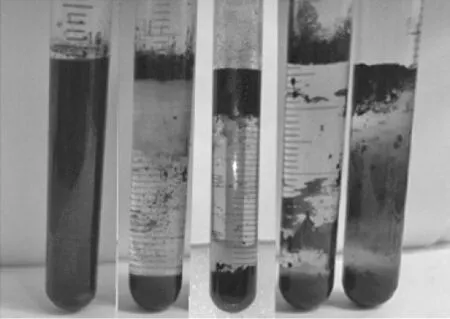
Figure 7 Influence of ratio of dichloromethane to [Emim][BF4] on the bitumen recovery
3.3 Optimization of separation conditions
The optimal ratio of dichloromethane to [Emim][BF4]was investigated during extraction of bitumen. The amount of oil sands and dichloromethane was maintained at 4.0 g and 10 mL, respectively. (The ratio of oil sands to dichloromethane was chosen to achieve a relatively small amount of dichloromethane used to reduce cost.)The volume of [Emim][BF4] was varied from 1 mL to 10 mL. With the increase of [Emim][BF4] content, the bitumen recovery yield increased at first and decreased afterwards. The best efficiency reached 92.0% when the volume ratio of dichloromethane to [Emim][BF4] was 5:2 (Table 1). Additionally, other organic molecules(e.g., methanol, ethanol, acetone) along with other ionic liquids (e.g., [Bmim][BF4], [Bmmim][BF4], [Emim]Cl)were also tried in the experiments (not shown here). The results indicated that only the combination of [Emim][BF4] and dichloromethane could make bitumen autopartitioned to a separate immiscible phase. In view of the complex structure of ILs as well as a variety of organic solvents, it was difficult to screen suitable combination of IL and organic solvent by experimental test. Accordingly,we proposed that the simulation method would be an effective supplementary means to reduce test workload and save experimental cost.
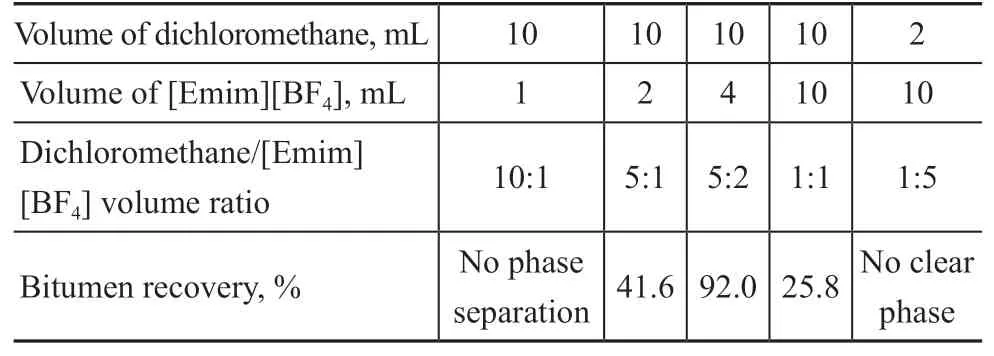
Table 1 Influence of ratio of dichloromethane to [Emim][BF4] on the bitumen recovery
3.4 Practicality of [Emim][BF4] enhanced extraction
The practical advantages of [Emim][BF4] assisted dichloromethane extraction were highlighted as follows: (i) Dichloromethane solvent was much cheaper(than alkanes, toluene) and less toxic (than toluene,benzene), and was suitable for a large-scale process.(ⅱ) Dichloromethane had low boiling point, which was conducive to low energy consumption of solvent recovery.(ⅲ) [Emim][BF4] could separate dichloromethane from the spent sand, and thereby the issue associated with solvent residue in the spent sand was addressed. (ⅳ) A separate bitumen phase formed by [Emim][BF4]-CH2Cl2extraction decreased the distillation energy consumption to a great extent. (v) Dichloromethane and [Emim][BF4]were reused 10 times with bitumen recovery efficiency ranging from 88 % to 94% (Figure 7). It was estimated that 10-20 times of IL reusing would make the process cheaper than conventional solvent extraction[15,22]. (ⅵ)[Emim][BF4] with lower viscosity than [Bmmim][BF4]offered a fast sedimentation of sand and clay, and could reduce the transportation energy consumption in the ILs involved process.
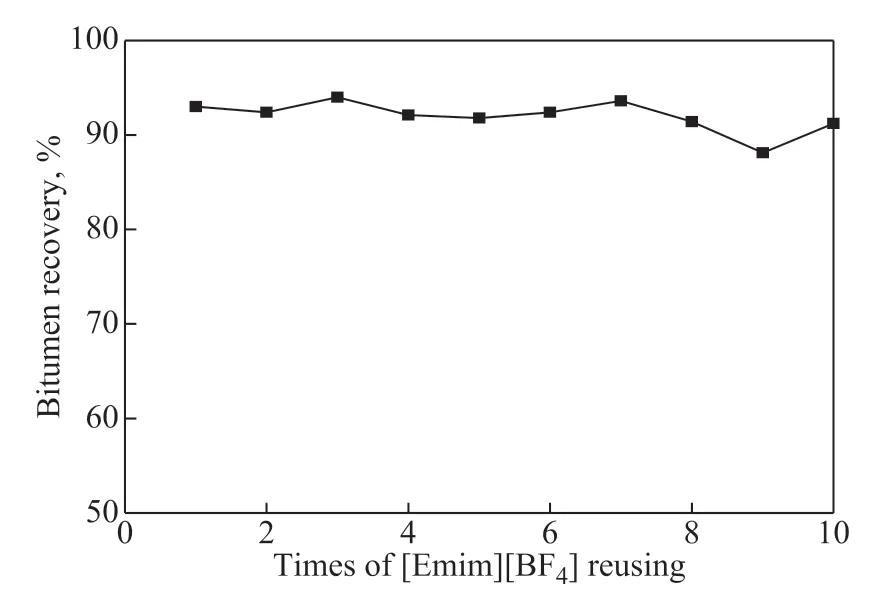
Figure 7 Performance of [Emim][BF4] after reusing
4 Conclusions
The technology of bitumen recovery from oil sands using dichloromethane and [Emim][BF4] mixture was proposed in this study. The results demonstrated that the bitumen recovery efficiency was increased up to 92%.After reusing of [Emim][BF4] for 10 times, the bitumen recovery remained at more than 88%. Hydrophilic [Emim][BF4] played an important role as it possessed both polar and non-polar regions on a microscopic level. On one hand, its high polarity made it immiscible with the extracted bitumen but miscible with dichloromethane,which kept the bitumen apart from dichloromethane.On the other hand, its hydrophobic side groups could drive the mass transfer of the extracted bitumen to the interface where the bitumen could be auto-partitioned to form a separate immiscible phase, which might avoid high energy consumption for distillation. Additionally,low price and low boiling point of dichloromethane, as well as the reusable performance of [Emim][BF4] and dichloromethane would further decrease the industrial operating cost. In a word, this study encouraged the extension of the bitumen recovery technology using[Emim][BF4] and dichloromethane mixture from bench scale testing to the large scale oil sand industry.
Acknowledgment:The authors gratefully acknowledge the support from the National Natural Science Foundation of China(Grant No. 21406101) and the Key Research and Development Plan of Liaoning Province (Grant No. 2020JH2/10300061).
杂志排行
中国炼油与石油化工的其它文章
- Effect of Acidity on Methylation of Benzene with Methanol Catalyzed by HZSM-5: A DFT Study
- Study on Reducing Injection Pressure of Low Permeability Reservoirs Characterized by High Temperature and High Salinity
- Heat Transfer and Kinetics Study of Moroccan Oil Shale Pyrolysis Process
- Application of a New Catalyst Deactivation Model for Residue Hydrotreating
- Corrosion Inhibition of the Bi-enzyme Doped Epoxy Resin for Q235 Carbon Steel in Circulating Cooling Water
- Heat Exchanger Network Retrofit of Diesel Hydrotreating Unit Using Pinch Analysis
